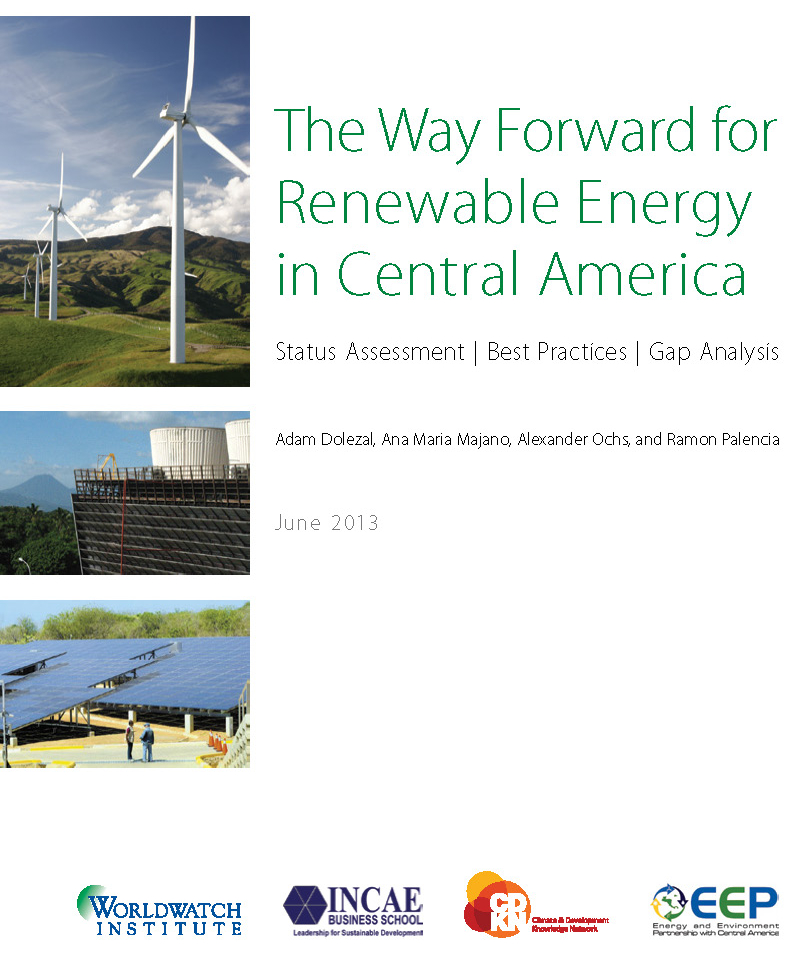The report focuses on the status of renewable energy technologies in Central America and analyzes the conditions for their advancement in the future. It identifies important knowledge and information gaps and evaluates key finance and policy barriers, making suggestions for how to overcome both. As such, this study is a “roadmap of a roadmap”—it scopes the improvements that need to happen with regard to the key components of a sustainable energy system and establishes the necessary methodology and groundwork for comprehensive national energy strategies.
Among the report’s key findings:
- Central America, long a frontrunner in hydropower and geothermal energy, is exploring its potential for expanding these technologies in a more sustainable manner while also developing other renewable energy resources such as wind, solar, biofuels, and agricultural waste. Costa Rica is leading the world in its ambition to be “carbon neutral” by 2021.
- Still, as the economies of Belize, Costa Rica, El Salvador, Guatemala, Honduras, Nicaragua, and Panama expand, use of fossil fuels is on the rise, while the use of fuelwood, primarily for cooking, continues to be unsustainably high.
- Across the region, an estimated 7 million people still have limited or no access to electricity services. Renewables are the only convincing and affordable solution to provide underserved communities that are far from existing grids with access to modern energy services.
- Central America’s non-hydro renewable electricity share is 13 percent, impressive when compared to the global average of only 5 percent. The urgent challenge for the region is to build on past successes and avoid locking in economically, socially, and environmentally costly fossil fuels for decades to come.
- The potentials for renewables are enormous: Geothermal alone could satisfy nearly twice the region’s predicted electricity demand through 2020. Existing regional wind powerinstallations currently use less than 1% of the available resource potential. Solar and biomass have enormous potentials throughout the region.
- Despite their sustainable energy ambitions and policy statements, the seven countries of Central America have been unable to comprehensively design, synchronize, and implement the program of work necessary to promote sustainable energy solutions to their full potential.
- The full costs and benefits to society of specific energy development options remain unclear. What is evident, however, is that the region pays an enormous socioeconomic price for its reliance on fuelwood and imported fossil fuels.
- Most Central American countries have been able to greatly improve their investment climate for sustainable energy. Still, powerful financial barriers remain, ranging from the unavailability of capital and the lack of human expertise, to investment insecurity and costly administrative processes.
- Most countries in the region have concrete policy mechanisms in place for advancing renewables.These policies and measures, however, are not always sufficient to level the playing field with fossil fuels, which are subsidized (directly and/or indirectly) in all Central American countries.
In all Central American countries, a rapid transition to 100% renewable electricity generation is both technically possible and socioeconomically beneficial. To support this transition, we suggest four areas for improvement in knowledge and communication as well as four areas for improvement in finance and policy:
Addressing knowledge and communication barriers:
- Produce additional, detailed assessments of renewable resource potentials in the region and make them publicly available;
- Assess renewable resource technical potentials against existing and future electricity load curves, and harvest renewable resources in tandem with energy efficiency and smart grid solutions, via an integrated energy planning approach;
- Assess and communicate widely the full socioeconomic impacts of different energy scenarios, including impacts on local economies and job creation; and
- Increase efforts to support national and regional renewable energy research; boost public awareness of renewables; and strengthen the related knowledge and human resource capacities of the government, banking, and private industry sectors.
Addressing finance and policy barriers:
- Mainstream renewable energy policies and goals among the diverse government agencies;
- Evaluate existing policy instruments related to renewables and, where necessary, refine the policy mix;
- Streamline administrative processes for developing new renewable energy projects and make them less costly and time intensive; and
- Establish clear indicators for measuring, evaluating, and reporting progress on renewable energy policies and investment environments.
Central America can power its economies in large part with renewable energy sources, helping the region to address some of its most pressing development challenges. What is needed now is the continued, collaborative effort of researchers, governments, and the private sector to help realize this goal.
Click to download a copy of the report: English Version & Spanish Version
The Way Forward for Renewable Energy in Central America
This project supported by:




 View Map
View Map